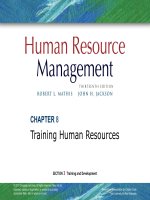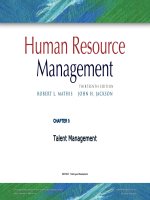Human resrouce management 13th mathis jacson chapter 015
Bạn đang xem bản rút gọn của tài liệu. Xem và tải ngay bản đầy đủ của tài liệu tại đây (1.29 MB, 43 trang )
CHAPTER 15
Employee Rights and Responsibilities
SECTION 5 Employee Relations
©
© 2011
2011 Cengage
Cengage Learning.
Learning. All
All rights
rights reserved.
reserved. May
May not
not be
be scanned,
scanned, copied
copied or
or duplicated,
duplicated, or
or posted
posted to
to aa
publicly
publicly accessible
accessible Web
Web site,
site, in
in whole
whole or
or in
in part.
part.
PowerPoint
PowerPoint Presentation
Presentation by
by Charlie
Charlie Cook
Cook
The
The University
University of
of West
West Alabama
Alabama
Chapter Objectives
After you have read this chapter, you should be able to:
•
Define employment-at-will and discuss how wrongful discharge, just cause, and due process are
interrelated.
•
•
•
•
•
Identify employee rights associated with free speech and access to employee records.
Discuss issues associated with workplace monitoring, employer investigations, and drug testing.
List elements to consider when developing an employee handbook.
Describe different kinds of absenteeism and how to measure it.
Differentiate between the positive approach and the progressive approach to discipline.
© 2011 Cengage Learning. All rights reserved. May not be scanned, copied or duplicated, or posted to a publicly accessible Web
site, in whole or in part.
15–2
Employee Rights and Responsibilities
• Rights
That which belongs to a person by law, nature, or tradition.
• Responsibilities
Obligations to perform certain tasks and duties.
• Statutory Rights
Rights based on specific laws and statutes passed by federal, state, and local governments.
Equal employment opportunity
Collective bargaining
Workplace safety
© 2011 Cengage Learning. All rights reserved. May not be scanned, copied or duplicated, or posted to a publicly accessible Web
site, in whole or in part.
15–3
Contractual Rights
• Contractual Rights
Rights based on a specific contract between employer and employee.
• Employment Contract
An agreement that formally outlines the details of employment.
• Implied Contract
The idea that a contract exists between the employer and the employee based on the implied
promises of the employer.
© 2011 Cengage Learning. All rights reserved. May not be scanned, copied or duplicated, or posted to a publicly accessible Web
site, in whole or in part.
15–4
FIGURE 15–1
Provisions in Employment
Contracts
© 2011 Cengage Learning. All rights reserved. May not be scanned, copied or duplicated, or posted to a publicly accessible Web
site, in whole or in part.
15–5
Contractual Rights (cont’d)
• Non-Compete Agreements
Prohibit individuals who quit from competing with an employer in the same line of business
for a specified period of time.
Employment Contract Clauses
Non-piracy agreements
Non-solicitation of current employees
Intellectual property and trade
secrets
© 2011 Cengage Learning. All rights reserved. May not be scanned, copied or duplicated, or posted to a publicly accessible Web
site, in whole or in part.
15–6
Contractual Rights (cont’d)
• Employer’s Intellectual Property Rights:
The right to keep trade secrets confidential
The right to have employees bring business opportunities to the employer first before
pursuing them elsewhere
A common-law copyright for works and other documents prepared by employees for their
employers
© 2011 Cengage Learning. All rights reserved. May not be scanned, copied or duplicated, or posted to a publicly accessible Web
site, in whole or in part.
15–7
Contractual Rights (cont’d)
• Employment Practices Liability Insurance (EPLI)
Covers employer’s costs for legal fees, settlements, and judgments associated with
employment-related actions.
© 2011 Cengage Learning. All rights reserved. May not be scanned, copied or duplicated, or posted to a publicly accessible Web
site, in whole or in part.
15–8
Rights Affecting the Employment Relationship
Employment-at-Will (EAW)
Wrongful and Constructive
Discharge
The Employment
Just Cause
Relationship
Due Process
Distributive and Procedural Justice
© 2011 Cengage Learning. All rights reserved. May not be scanned, copied or duplicated, or posted to a publicly accessible Web
site, in whole or in part.
15–9
Employment-at-Will (EAW)
Employers
Employees
Employers have the right to hire, fire, demote,
Employees have the right to quit and got another
or promote as they choose, unless there is a law
job under the same constraints.
or contract to the contrary.
© 2011 Cengage Learning. All rights reserved. May not be scanned, copied or duplicated, or posted to a publicly accessible Web
site, in whole or in part.
15–10
Employment-at-Will (cont’d)
Exceptions to EAW
Violation of Public Policy
Implied Contract of Continuing
Covenant of Good-faith and
Employment
Fair-dealing
© 2011 Cengage Learning. All rights reserved. May not be scanned, copied or duplicated, or posted to a publicly accessible Web
site, in whole or in part.
15–11
Employment-at-Will Restrictions
• Wrongful Discharge
Termination of an individual’s employment for reasons that are improper or illegal.
Fortune v. National Cash Register Company
• Constructive Discharge
An employer deliberately makes working conditions intolerable for an employee in an attempt
to get (to force) that employee to resign or quit.
© 2011 Cengage Learning. All rights reserved. May not be scanned, copied or duplicated, or posted to a publicly accessible Web
site, in whole or in part.
15–12
FIGURE 15–2
Keys for Preparing a Defense against Wrongful Discharge
© 2011 Cengage Learning. All rights reserved. May not be scanned, copied or duplicated, or posted to a publicly accessible Web
site, in whole or in part.
15–13
Employment-at-Will: Fairness
• Just Cause
Reasonable justification for taking an employment-related action.
• Due Process
The means used for individuals to explain and defend their actions against charges or
discipline.
Distributive Justice
–
Perceived fairness in the distribution of outcomes
Procedural Justice
–
Perceived fairness of the process used to make decision
Interactional Justice
–
Perceived fairness about how a person interacts with others
© 2011 Cengage Learning. All rights reserved. May not be scanned, copied or duplicated, or posted to a publicly accessible Web
site, in whole or in part.
15–14
FIGURE 15–3
Criteria for Evaluating Just Cause and Due Process
© 2011 Cengage Learning. All rights reserved. May not be scanned, copied or duplicated, or posted to a publicly accessible Web
site, in whole or in part.
15–15
Work-Related Alternative Dispute Resolution (ADR)
Alternative Dispute Resolution
Methods
Arbitration
Peer Review Panels
Ombuds
© 2011 Cengage Learning. All rights reserved. May not be scanned, copied or duplicated, or posted to a publicly accessible Web
site, in whole or in part.
15–16
Managing Individual Employee and Employer Rights Issues
• Right to Privacy
An individual’s freedom from unauthorized and unreasonable intrusion into personal affairs.
• Privacy Rights and Employee Records:
Access to personal information held by employer
Response to unfavorable information in records
Correction of erroneous information
Notification when information is given to a third party
© 2011 Cengage Learning. All rights reserved. May not be scanned, copied or duplicated, or posted to a publicly accessible Web
site, in whole or in part.
15–17
Privacy Rights and Employee Records
• ADA Provisions
Employee medical records are to be kept as separate confidential files available under
limited conditions specified in the ADA.
• Security of Employee Records
Restrict access to all records
Set confidential passwords to HR databases
Keep sensitive information in separate files and restricted databases
Inform employees about data retained
Purge outdated data from records
Release information only with employee’s consent
© 2011 Cengage Learning. All rights reserved. May not be scanned, copied or duplicated, or posted to a publicly accessible Web
site, in whole or in part.
15–18
FIGURE 15–4
Employee Record Files
© 2011 Cengage Learning. All rights reserved. May not be scanned, copied or duplicated, or posted to a publicly accessible Web
site, in whole or in part.
15–19
Employees’ Free Speech Rights
Employers’ Restrictions on Employees’ Free Speech
Rights
Advocacy of Controversial
Views
Publication of Blogs and Wikis
Engaging in Whistle-Blowing
© 2011 Cengage Learning. All rights reserved. May not be scanned, copied or duplicated, or posted to a publicly accessible Web
site, in whole or in part.
15–20
Employee Rights and Personal Behavior
Body Appearance
Off-Duty Behavior
An employer can place legitimate job-related
An employer can discipline an employee if the
limits on an employee’s personal at-work
employee’s off-the-job behavior puts the
appearance such as tattoos and body piercings.
company in legal or financial jeopardy.
© 2011 Cengage Learning. All rights reserved. May not be scanned, copied or duplicated, or posted to a publicly accessible Web
site, in whole or in part.
15–21
FIGURE 15–5
Recommended Employer Actions
Regarding Electronic
Communications
© 2011 Cengage Learning. All rights reserved. May not be scanned, copied or duplicated, or posted to a publicly accessible Web
site, in whole or in part.
15–22
E-mail and Voice Mail
• Electronic Communications Policy Elements
Voice mail, e-mail, and computer files are provided by the employer and are for business use
only.
Use of these media for personal reasons is restricted and subject to employer review.
All computer passwords and codes must be available to the employer.
The employer reserves right to monitor or search any of the media, without notice, for
business purposes.
© 2011 Cengage Learning. All rights reserved. May not be scanned, copied or duplicated, or posted to a publicly accessible Web
site, in whole or in part.
15–23
Employee Misconduct
Illegal Drug
Sample
Use
Employee
Falsification of Documents
Sample
Theft
Types of
Sample
Employee
Misconduct
Employment
Harassment
Sample
Misuse ofSample
Company Funds
Workplace
Disclosure of Organizational
Violence
Secrets
Sample
Sample
© 2011 Cengage Learning. All rights reserved. May not be scanned, copied or duplicated, or posted to a publicly accessible Web
site, in whole or in part.
15–24
Balancing Employer Security
and Employee Rights
Workplace Monitoring
•
•
•
Monitoring e-mail and voicemail
Conducting video surveillance at work
Monitoring employee performance
Employer Investigations
•
•
•
Conducting work-related investigations
Employee theft
Honest and polygraph tests
© 2011 Cengage Learning. All rights reserved. May not be scanned, copied or duplicated, or posted to a publicly accessible Web
site, in whole or in part.
15–25









